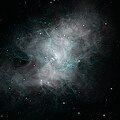File:M1, NGC 1952, Crab Nebula (noao-crab3).jpg
From Wikimedia Commons, the free media repository
Jump to navigation
Jump to search

Size of this preview: 600 × 600 pixels. Other resolutions: 240 × 240 pixels | 480 × 480 pixels | 768 × 768 pixels | 1,024 × 1,024 pixels | 2,048 × 2,048 pixels | 2,690 × 2,690 pixels.
Original file (2,690 × 2,690 pixels, file size: 2.26 MB, MIME type: image/jpeg)
File information
Structured data
Captions
Captions
This is an enhanced color composite formed from two images of the well-known Crab Nebula, taken on the night of October 27th 1995 with the NOAO/STIS/Tektronix 2048x2048 CCD detector on the 3.5-meter WIYN telescope.
Summary
[edit]| DescriptionM1, NGC 1952, Crab Nebula (noao-crab3).jpg |
English: This is an enhanced color composite formed from two images of the well-known Crab Nebula, taken on the night of October 27th 1995 with the NOAO/STIS/Tektronix 2048x2048 CCD detector on the 3.5-meter WIYN telescope. At the focal plane of the WIYN, this detector has a sampling scale of 0.2 arc seconds per pixel. This picture shows the full imaging power of the WIYN telescope: the "seeing", or image size, is about 0.6 arc seconds, or about twice the resolution of typical ground-based images. Some shell-like features in the center of the nebula, and the subtle filamentary structure evident throughout the region, are impossible to see in fuzzier (that is, more typical) pictures. This picture has been enhanced from its original appearance using unsharp masking, to reveal even more clearly the amazing filamentary detail brought to light by the excellent image quality attainable with the WIYN telescope. About this object The Crab Nebula was originally given this name due to its resemblance to a crab's claw in an early sketch made in 1855 by Lord Rosse's staff astronomer R.J. Mitchell. It is the remnant of a supernova explosion in the year 1054 A.D., which was recorded in five separate accounts in the Far East, although, oddly, no western observation has survived. The nebula was probably first noticed in 1731 by John Bevis, and it was significant enough to be the first entry in Charles Messier's list of nebulae (compiled to avoid mistaking them for comets). The nebula continues to expand and change the details of its appearance, and this is partly due to the violence of the original explosion. However, the star which exploded left behind a rotating neutron star, which continues to beam energy out into the nebula, as well as flashing with a period of only 33 milliseconds. The details of this energy input are important for our understanding both of neutron stars and of the physical conditions in the nebula, and are revealed in the patterns of filaments, their brightness and colors, and the way they change with time. |
| Date | 30 June 2020, 21:34:00 (upload date) |
| Source | M1, NGC 1952, Crab Nebula |
| Author | Jay Gallagher (U. Wisconsin), N.A. Sharp (NOAO)/WIYN/NOIRLab/NSF |
| Other versions |
|
Licensing
[edit]This media was created by the National Optical-Infrared Astronomy Research Laboratory (NOIRLab).
Their website states: "Unless specifically noted, the images, videos, and music distributed on the public NOIRLab website, along with the texts of press releases, announcements, images of the week and captions; are licensed under a Creative Commons Attribution 4.0 International License, and may on a non-exclusive basis be reproduced without fee provided the credit is clear and visible." To the uploader: You must provide a link (URL) to the original file and the authorship information if available. | |
This file is licensed under the Creative Commons Attribution 4.0 International license.
| |
File history
Click on a date/time to view the file as it appeared at that time.
| Date/Time | Thumbnail | Dimensions | User | Comment | |
|---|---|---|---|---|---|
| current | 19:06, 17 September 2023 |  | 2,690 × 2,690 (2.26 MB) | OptimusPrimeBot (talk | contribs) | #Spacemedia - Upload of https://noirlab.edu/public/media/archives/images/large/noao-crab3.jpg via Commons:Spacemedia |
You cannot overwrite this file.
File usage on Commons
The following page uses this file:
Metadata
This file contains additional information such as Exif metadata which may have been added by the digital camera, scanner, or software program used to create or digitize it. If the file has been modified from its original state, some details such as the timestamp may not fully reflect those of the original file. The timestamp is only as accurate as the clock in the camera, and it may be completely wrong.
| Image title |
|
|---|---|
| Credit/Provider | Jay Gallagher (U. Wisconsin), N.A. Sharp (NOAO)/WIYN/NOIRLab/NSF |
| Source | NSF's NOIRLab |
| Short title |
|
| Usage terms |
|
| Date and time of data generation | 21:34, 30 June 2020 |
| Keywords |
|
| Contact information |
950 North Cherry Ave. Tucson, AZ, 85719 USA |
| IIM version | 4 |

